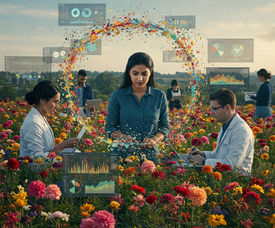The Algorithmic Steward: AI Orchestrating a Sustainable and Eco-Conscious Construction Revolution
- Tretyak
- 6 days ago
- 5 min read

The construction industry, a colossal force shaping our physical world, bears a profound responsibility for its environmental footprint. From the extraction of raw materials to the energy consumption of buildings, its impact is undeniable. However, Artificial Intelligence (AI) is emerging as a transformative force, evolving from a simple efficiency tool to a "hyperdimensional ecological steward," capable of orchestrating a quantum leap towards a truly sustainable and regenerative built environment. We are moving beyond minimizing harm to actively healing and enhancing our planet through intelligent construction.
I. Hyperdimensional Life Cycle Assessment (LCA): AI as the Quantum Oracle of Environmental Footprints
Quantum-Enhanced Environmental Impact Modeling:
AI transcends traditional LCA by employing quantum-inspired algorithms and hyperdimensional data analysis to model the environmental impact of buildings and infrastructure with unprecedented precision and granularity. This involves:
Analyzing the carbon footprint of materials across their entire supply chain, considering extraction, processing, transportation, and end-of-life scenarios.
Simulating the long-term energy consumption of buildings under various climate conditions and occupancy patterns.
Modeling the impact of construction activities on biodiversity, water resources, and air quality.
Imagine AI systems that can:
Predict the environmental consequences of design choices in real-time, allowing architects to optimize for sustainability from the outset.
Evaluate the circularity potential of building materials, promoting reuse and recycling.
Quantify the ecological benefits of green infrastructure, such as green roofs and urban forests.
Cognitive Resource Flow Optimization and the Genesis of a Circular Construction Economy:
AI moves beyond simple waste reduction, developing cognitive architectures to optimize the flow of resources in the construction industry, fostering a circular economy where materials are reused and repurposed. This involves:
Tracking the flow of materials on construction sites, minimizing waste through precise material delivery and cutting techniques.
AI-powered systems that sort and recycle construction debris, diverting materials from landfills.
Designing buildings for deconstruction, allowing for easy disassembly and reuse of components.
Imagine AI systems that can:
Coordinate the exchange of materials between different construction sites.
Identify opportunities to use recycled materials in new projects.
Predict the future availability of resources and adapt construction practices accordingly.
Sentient Climate Change Adaptation and the Genesis of Resilient Built Environments:
AI facilitates the design and construction of buildings and infrastructure that are resilient to the impacts of climate change, adapting to extreme weather events and changing environmental conditions. This involves:
Modeling the impact of climate change on building performance, considering factors like sea-level rise, extreme heat, and increased storm intensity.
Designing structures that can withstand these challenges, incorporating features like flood-resistant foundations and passive cooling systems.
Developing AI-driven early warning systems to protect construction sites and communities from climate-related disasters.
Imagine buildings that can:
Automatically adjust their ventilation and shading systems to optimize indoor comfort and energy efficiency.
Adapt to changes in temperature and rainfall, ensuring the safety and well-being of occupants.
Generate their own power and store excess energy for use during power outages.
II. AI in Action: A Hyperdimensional Symphony of Ecological Intelligence in Construction
AI-Orchestrated Hyper-Efficient Material Selection and the Genesis of Carbon-Negative Construction:
AI revolutionizes material selection by analyzing a vast database of materials, considering factors like embodied carbon, recyclability, and durability, to minimize the environmental footprint of construction. This involves:
AI algorithms that can assess the environmental impact of different materials, including their carbon footprint and life cycle analysis data.
AI-powered tools that recommend sustainable alternatives to traditional materials, such as recycled concrete or bio-based composites.
AI systems that can optimize material sourcing and transportation to reduce emissions.
Imagine buildings constructed from materials that:
Actively absorb carbon dioxide from the atmosphere.
Are grown from living organisms or manufactured from waste products.
Can self-repair and adapt to changing environmental conditions.
AI-Driven Hyper-Precise Construction Processes and the Genesis of Zero-Waste Building:
AI optimizes construction processes to minimize waste, reduce energy consumption, and improve efficiency. This involves:
AI-guided robots that precisely cut and assemble materials, reducing errors and waste.
AI-powered systems that monitor energy consumption on construction sites and optimize equipment usage.
AI tools that track waste generation and optimize recycling efforts.
Imagine construction sites that:
Operate with near-zero waste, reusing and recycling all materials.
Use renewable energy sources to power equipment and operations.
Leave minimal impact on the surrounding environment.
AI-Enhanced Hyper-Regenerative Building Operation and the Genesis of Living Ecosystems:
AI facilitates the design and operation of buildings that not only minimize their environmental impact but also actively contribute to the health and well-being of the surrounding environment. This involves:
AI-driven building management systems that optimize energy consumption, water usage, and indoor air quality.
Integration of green infrastructure, such as green roofs and walls, to enhance biodiversity and improve air quality.
Creation of buildings that function as living ecosystems, providing habitats for plants and animals and contributing to the overall health of the urban environment.
Imagine buildings that:
Purify the air and water, contributing to the health of the surrounding community.
Provide habitats for birds and insects, enhancing biodiversity.
Create a sense of connection to nature for their occupants.
III. The Ethical and Philosophical Conundrums: Navigating the Algorithmic Frontier of Sustainable Construction
The increasing sophistication of AI in sustainable construction raises profound ethical and philosophical questions that require careful consideration and responsible navigation:
Data Ownership and Access in a Hyper-Connected Building Ecosystem: Who owns the vast amounts of data generated by buildings and their occupants? How do we protect the privacy and security of this data while ensuring its effective use for optimizing building performance and improving sustainability?
Algorithmic Bias and Environmental Justice in the Design of Sustainable Cities: How do we ensure that AI algorithms used for urban planning and building design are fair, equitable, and do not perpetuate existing environmental inequalities or disproportionately impact vulnerable communities? What measures can be taken to promote environmental justice in AI-driven urban development?
The impact of AI on the future of the construction workforce and the creation of new "green jobs" in the industry.
The potential for AI to be used for manipulative purposes, such as greenwashing or the creation of buildings that prioritize efficiency over human well-being.
IV. The Quantum Future: A Hyperdimensional Symphony of Ecological Intelligence and the Genesis of a Thriving Planet
As AI technology continues to advance, augmented by quantum computing, advanced sensor networks, cognitive architectures, and a deeper understanding of ecological systems, we can expect to see even more groundbreaking applications in sustainable construction. The future is not just about building structures; it's about co-creating a hyperdimensional symphony of ecological intelligence, where human ingenuity and algorithmic power merge to shape a built environment that is truly regenerative, resilient, and life-enhancing for all.
Imagine:
AI-powered systems that can autonomously design and construct buildings that adapt to changing environmental conditions and contribute to the health of the planet.
Sentient buildings that can communicate with their surroundings, optimizing their performance and interacting with the urban ecosystem.
Quantum-enhanced simulations of urban metabolism, allowing us to create cities that function as closed-loop systems, minimizing waste and maximizing resource reuse.
The journey into this new era is both exciting and fraught with challenges. By engaging in thoughtful ethical consideration, promoting transparency and accountability, and embracing a collaborative approach, we can harness the transformative potential of AI to create a future where the built environment is a force for positive change, contributing to the well-being of both Humanity and the Planet.































































































Comments